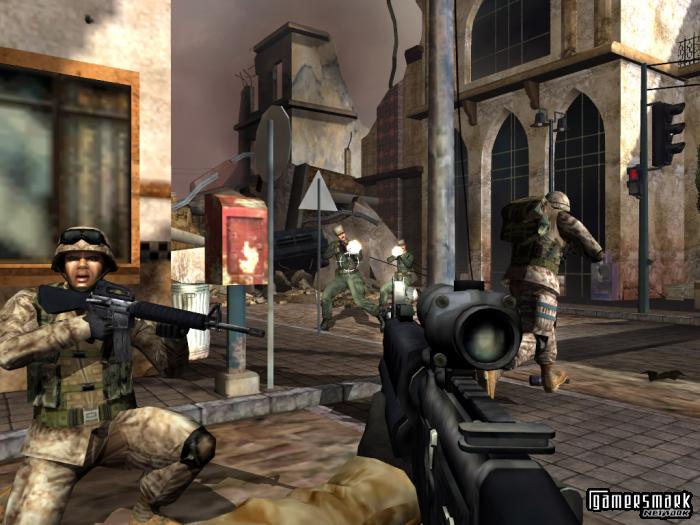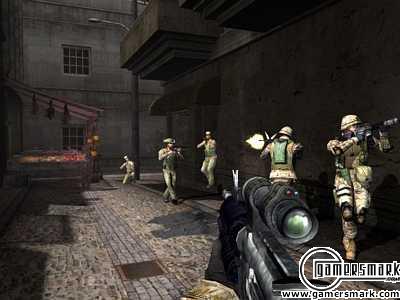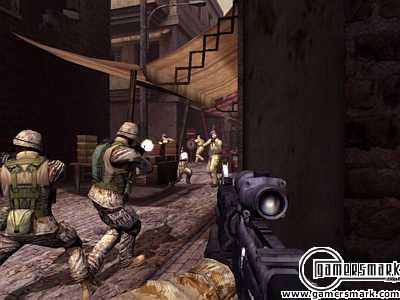Developer: Destineer / Publisher: 2K Games || Overall: 6.8/10
With the current wars in Afghanistan and Iraq, there has recently been quite an upsurge of FPS’s that take place in the Middle East. Close Combat: First to Fight takes its place among the many recent FPS titles that allow you to shoot at radical Arabs. In this striving-to-be-realistic shooter, you take on the role of a Marine lance corporal (put simply, the leader) in a four person squad of America’s few and proud. The game is based on imagined “occurrences” taking place in Lebanon, in the distant year of 2006. You will play an important part in resolving the problems between Lebanese radicals and the Syrians who help them.
First to Fight will take you through building after building and street after street, gunning down these stereotypically radical Arabs with turbans and beards, who shoot at you with AK-47 bootlegs called AK-74s, all while yelling in Arabic, or rather what they try to pass off as Arabic; it’s mostly just incoherent yelling. With the help of forty U.S. Marines fresh out of battle from Iraq, First to Fight claims to be so realistic that the Marines use it as a training tool. Given this logic, however, one could say that Pac-Man could also be used as a training tool for the Marines. Fact of the matter is, I doubt very seriously that First to Fight is actually used for training; while it tries to be realistic, it’s really not. It even says on the box it’s not approved, endorsed or authorized by the Marine Corps or any other component of the Department of Defense, which isn’t surprising, because First to Fight is not realistic enough that it could be used as a “training tool,” despite it’s claims.
The main goal of First to Fight was to be a realistic representation of how real-life U.S. Marines operate in battle. With a few squad-based commands, you’ll go around shooting your 3-shot-burst rifle, raiding rooms, killing enemies using truck-mounted machine guns (realistically, with no recoil), all while being jealous at the fact the other member in your squad gets the cool gun. This is hardly a realistic representation. While the settings they put you in look fairly “realistic,” they also look like they could be the slums of a poor European city, especially after a few buildings were bombed out. If the Arabs were replaced with Nazis, it wouldn’t be too hard to believe this were a World War II game.
As mentioned before, First to Fight utilizes squad-based tactics as you make your way through the urban landscape. While it’s not purely command-based in the way you can utilize your squad SOCOM, in how you can send your team members to location points and all sorts of different advanced commands to complete the mission, you can give your Marines a few commands mainly consisting of Suppress, Cover, Take Down, and Frag Take Down. Suppress is usually used when you want to travel across a hot zone full of gunfire. When you enable this command, your Saw gunner (the guy with the really good gun) will start shooting in no particular direction, clearing the way for you to move across to another part of the area in conflict to get a better shot at the radicals. Cover is another tactic used to help you reposition yourself, but instead of firing in random directions, all of your squad members will stay in the place they are and make sure you make it across safely. Take Down and Frag Take Downs are used when you’re in a building, and is used very often when you want to clear a room you’re about to go in. In a regular Take Down, your marines will storm in and shoot everything they can. In a Frag Take Down, they’ll toss a grenade into the room, letting it explode and then charge in with guns-a-blazing. Using these four commands will be the only times you really have to control your marines. The rest of the time, the marvelous AI will take control of your marines, helping you shoot down those crazy radicals, most of the time taking more of the kills than you do. In the end, First to Fight tries to give off the impression that it is more complex than normal FPS games by having seemingly complicated explanations as to how your units work, but you learn within your first hour of playing that it doesn’t really matter you have a squad with you.
Starting a new campaign game will take you through “training levels” of sort in which tutorial videos are played to teach you about a particular aspect of the game. While there’s only a couple of these, the first one is fairly long, clocking in at about five minutes. The intro-tutorial video teaches you all about how the Marine squad operates, naming all the positions of the different people in the squad, and how they are automatically programmed to do things like Marines do (such as go down the sides of streets instead of down the middle). The tutorial video also makes it clear that your squad members are smarter than you when it comes to playing the game, so you really don’t have to help them every step of the way through your mission. While your squad-members do help out a lot, you tend to feel like a babysitter, healing your members when they need it, and always making sure they’re near you so you don’t risk losing two and failing the mission.
There is the option to request help from other Marine forces in the area, as you’re given a limited amount of times in which you can call in for an air strike or a sniper to help you out with a situation (as if they’ll only give you the favor a limited amount of times, not because they want you to finish the mission or anything).
The story is delivered through “news broadcasts” by the International News Network (which seems to be run by the British). This gives the feeling that you are playing the game on a “global” level rather than an individual level, while keeping up with the developments of what happens in the fictitious divergence. Consequently, you don’t actually have a story with the marines you impersonate. There is no drastic turn of plot events like the Marines disobeying orders and going into a dangerous part of town that hasn’t been secured yet in a valiant effort to be proclaimed as heroes, or anything that may have made an interesting story. Basically, all you do in the game is receive orders to go somewhere. After you get there, you shoot some guys to “secure” the area, then rinse and repeat. If you get a kick out of shooting people who pop out of doorways or from behind objects like a jack-in-the-box screaming fake Arabic, then get ready to have the time of your life, because that’s all this game is.
Even the most basic game play mechanics aren’t flawless. Too often when I walk around I feel like I’m tripping over something. The regular movement is very slow consequently, and if you decide to “sprint” there is an over-exaggerated swaying of the camera from left to right, making it difficult to really see where you’re going. You’re usually stuck with hobbling around with a floating gun. Although it is nice that they added it, melee attacks have no use at all. Using a melee attack grants no particularly advantage to its use, as you have plenty of ammo already to give out to the needy, and there are plenty of AK-74s lying around to pick up and use for yourself. There are also too many different commands on the keyboard for you to remember, probably more than what should have been necessary.
Keeping true to the games “realistic” approach, it doesn’t take too many hits for you to be killed. Also keeping true to this aspect, your enemies will randomly disappear! I wouldn’t have mentioned the enemies disappearing had it not happened more than four times (that I noticed) while I was shooting in their general direction, only to find that I had somehow vaporized them with my rifle bullets. I didn’t think the American military was THAT advanced. But the AI itself isn’t all that great to begin with. While the AI provides a fair challenge, (mostly due to the fact they look exactly like they’re surroundings) and because it doesn’t take much to kill you to begin with, you may run into some situations where you become careless, die and restart at the last checkpoint you passed. Quite often, the AI will stare at you for nearly a minute before deciding to do anything, making them very easy targets.
Despite all that I’ve said already, the presentation of the game isn’t bad. I found the music to be well-composed, lending a good feeling to the “modern-combat.” Even though this is a Middle Eastern-themed game, there is no Middle Eastern-sounding music in the background. Instead, it focuses on the triumphant “we’re-going-to-kill-you” feeling you should get from a FPS. The graphics also aren’t half-bad. While they definitely aren’t the greatest I’ve seen, they’re above average for a PC game. When you crank up the settings to their most advanced, you will have some nice visuals to look at. The settings show quite a bit of detail, and really make you feel as if you’re in a war-forlorn area. A downside to this; the minimum requirements to run First to Fight are quite demanding. With the requirements of a 1.3Ghz Pentium III, 256 mb RAM, 32 mb video card, broadband for multiplayer and 2.8 gb of hard drive space, your computer will have to be nearly top of the line to play without any slowdown with all the settings cranked up. On a side note, loading takes about an average amount of time, but most of the time it’s fairly quick.
I’m not sure how big of an importance multiplayer takes with First to Fight (even though it is an important aspect of all FPSes). Being squad-based, it doesn’t seem to me like it’d be realistic for people to follow all the rules your AI squad-members would adhere to. With two multiplayer modes, Four Man Co-Op and Head-to-Head, Four Man Co-Op seems to provide the only good mode to play this game online. If you like the single player missions included in the game, you’ll get through them about four times faster since there’ll be four guys running around the game shooting all the crazy Arabs they can find. If you wanted to play Head-to-Head, the urban settings found in the game could provide for some fun.
Oddly, I found the shooting of endless hordes of zombies in Deadhunt much more fun than playing this game. While First to Fight has a few good points about it, it does not live up to what it claims it is, and is “realistically” only a less than average FPS. Possibly the greatest fault of the game is the price tag it totes: an MSRP of $39.99. If the game were priced for a budget release, maybe half of what it is currently, this game could be worth a look to the FPS enthusiast.



